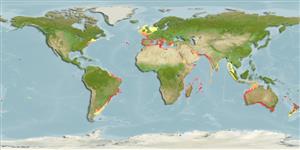Common names from other countries
Classification / Names / Names
Namen | Synonyme | Catalog of Fishes (gen., sp.) | ITIS | CoL | WoRMS
Environment: milieu / climate zone / depth range / distribution range
Ökologie
Pelagisch; tiefenbereich 0 - 200 m (Ref. 1134). Subtropical; 15°C - 27°C (Ref. 1134)
Warm waters of all oceans.
Length at first maturity / Size / Gewicht / Alter
Maturity: Lm ? range ? - ? cm Max length : 0.3 cm TL Männchen/unbestimmt; (Ref. 1610)
Minimum depth from Ref. 3475. Marine, planktonic; not deeper than 200 m (Ref. 1134). Prefers neritic ambience (Ref. 3531).
Life cycle and mating behavior
Geschlechtsreife | Fortpflanzung | Ablaichen | Eier | Fecundity | Larven
Members of the class Appendicularia are protandrous hermaphrodites. Life cycle: Eggs develop into hatchlings (feeding juveniles) before turning into adults.
Kott, P. 2005. (Ref. 1134)
IUCN Rote Liste Status (Ref. 130435)
CITES Status (Ref. 108899)
Not Evaluated
Not Evaluated
Nutzung durch Menschen
| FishSource |
Tools
Mehr Information
Alter/Größe
Wachstum
Länge-Gewicht
Länge-Länge
Morphologie
Larven
Dichte
Internet Quellen
Estimates based on models
Preferred temperature
(Ref.
115969): 15.8 - 26.9, mean 20.6 (based on 332 cells).
Verwundbarkeit
Low vulnerability (10 of 100).
Preiskategorie
Unknown.
